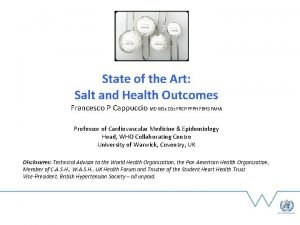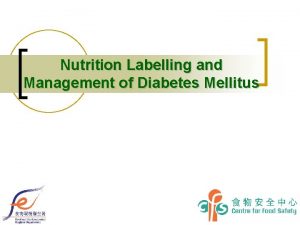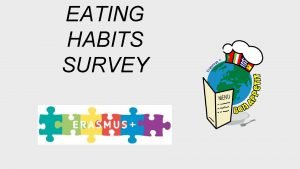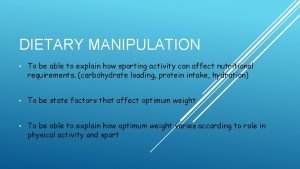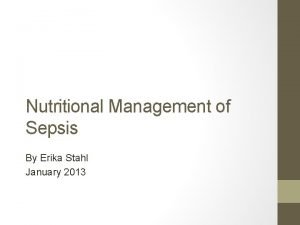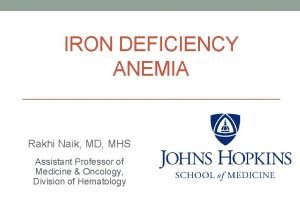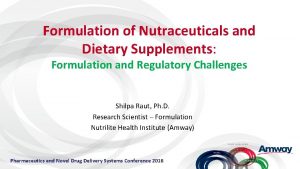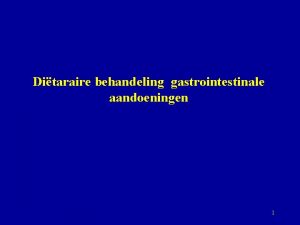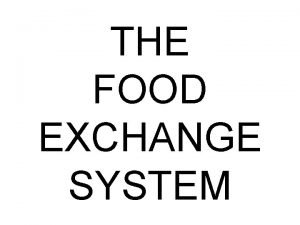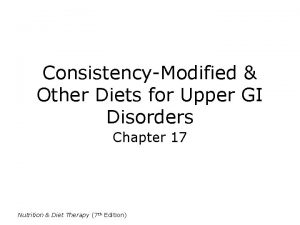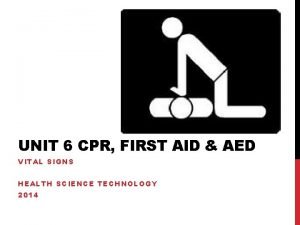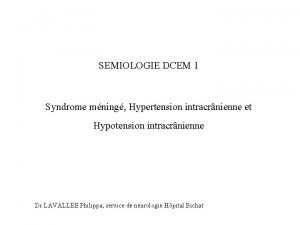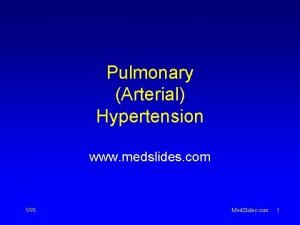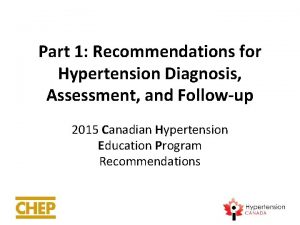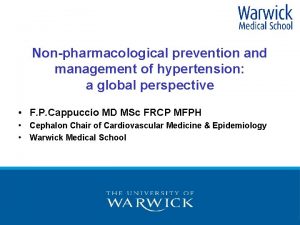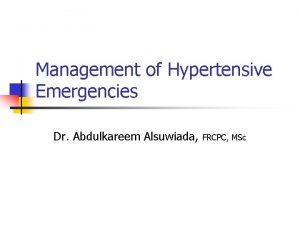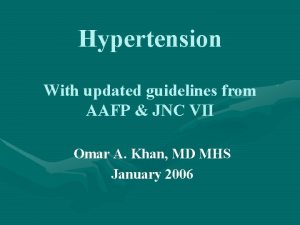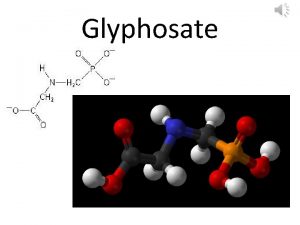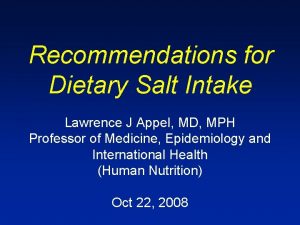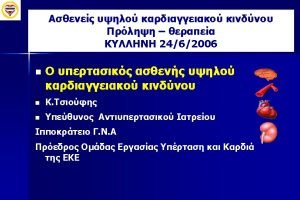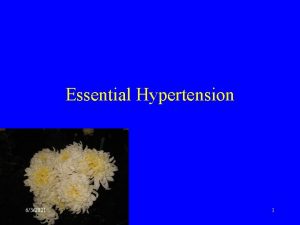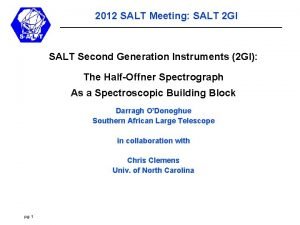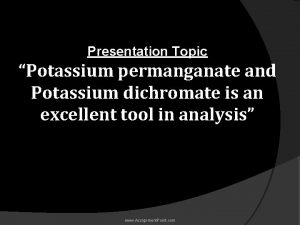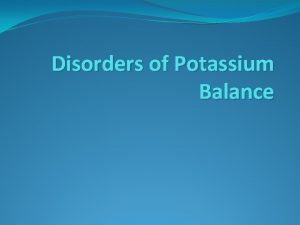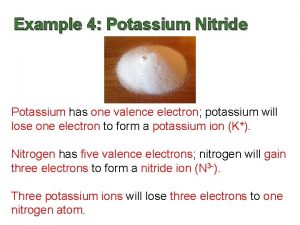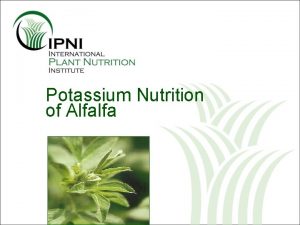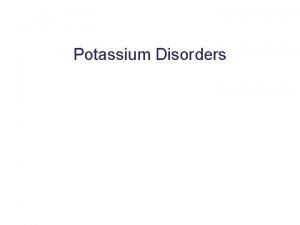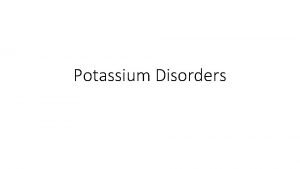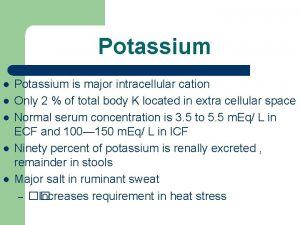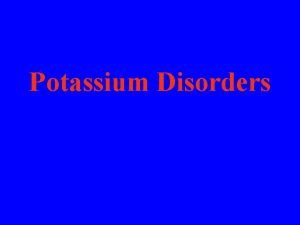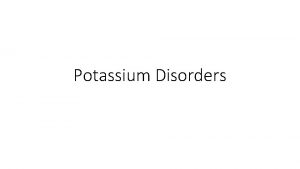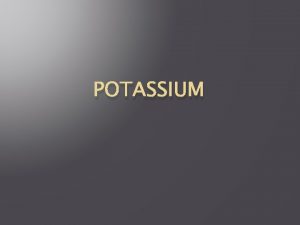Dietary Salt and potassium intake in Hypertension Evidence







































- Slides: 39

Dietary Salt and potassium intake in Hypertension 가톨릭 대학교 의과대학 내과학 교실 이승헌

Evidence of an adverse effect of high sodium intake on blood pressure o From animal study, population study, anthropology, clinical observations, epidemiology etc

Evidences in animal study o Study in chimpanzees chimpanzee diet에 extra salt(sodium chloride 15 g/day)를 20 개월간 주었을 때, progressive 한 혈압 상승이 관찰되었다. (SBP/DBP 각각 평균 33 mm. Hg/10 mm. Hg 상승) Salt supplement 중단시 혈압 상승이 회복됨. - Denton 등 Nat Med 1995; 1: 1009


Metaregression analysis of 40 randomized controlled trials in 2001 하루 77 mmol 의 염분제한은 고혈압군에서 수축기/이완기 각각 5. 2/3. 7 mm. Hg의 혈압 강하 효과가 있었으며, 정상 혈압군에서는 각각 1. 3/1. 1 mm. Hg 의 혈압 강하 효과가 관찰 되었다. - Geleijnse J Hum Hypertens 2003; 17: 471

Figure 2. Relationship of salt intake with frequency of blood pressure in different populations. F = data from the Framingham Study; D = data from Dahl. (Adapted from Mac. Gregor. )

DASH-sodium trial

Age-related hypertension o o Most commonly observed in industrialized societies Featuring habitual salt intake in excess of 120 mmol/day

Figure 4. Blood pressure changes with age and salt intakes. The rise in systolic blood pressure with age correlates with a higher sodium intake in two Polynesian populations. In men of Rarotonga island in Polynesia, where the sodium intake averages 130 mmol/day, (range 120– 140 mmol/day), systolic blood pressure increases with age. In contrast, it remains constant in men from Pukapuka island, where the sodium intake averages 50– 70 mmol/day (range 50– 70 mmol/day). (Adapted from Prior et al. )

Table 2. Effect of reduced dietary sodium on blood pressure.

Problems in trials o o Extent of sodium reduction : 기간, 용량등 의 문제로 antihypertensive potential을 확 실히 확인 하지 못하는 한계가 있었다. 최소한 6주이상, 하루 100 meq 이상의 sodium reduction이 요구된다. - Law MR 등 BMJ 1991; 302: 811 - Beard 등 Lancet 2003; 362: 403

Level of sodium intake o o o There is a threshold level of salt intake required for its pressor effect. Not all individuals are equally susceptible to this effect. Salt sensitive versus salt resistant

Salt and Hypertension, action mechanism o o o Sodium sensitivity - natural variation in pressure responsiveness, renal salt excretion 의 결함으로 초기 volume expansion 과 혈압상승이 발생한다. Increases in elderly people, African-American, obesity, renal insufficiency, insulin-dependent diabetes and patients on cyclosporin

Pathogenesis of sodium sensitivity o Alteration in circulating levels of (or renal responses to) Atrial natriuretic factor, kallikrein, prostaglandin and nitric oxide increased level of norepinephrine in plasma or urine

Sodium sensitivity o o Salt loading incresaes cathecolamine release or modifies adrenergic receptor binding Enhancing the effect of circulating CA cause vasoconstriction

Sodium sensitivity o o o Reduced renin level Abnormal suppression of both renin and aldosterone Sodium retention and volume expansion

Table 1. Characteristics of sodium–sensitive hypertension.

Figure 5. Increase in magnitude of sodium sensitivity with increasing age. Sodium sensitivity increases proportionately with age in both hypertensive and normotensive subjects (bars indicate SEM; * P < 0. 05). (Adapted from Weinberger and Fineberg. )

Figure 6. Sodium sensitivity and increased frequency of cardiovascular events in patients with hypertension. Kaplan–Meier plots indicating that patients with sodium–sensitive hypertension have an increased number of fatal and nonfatal cardiovascular events (such as angina pectoris, MI, and heart failure) compared with patients with sodium–resistant hypertension. (Adapted from Morimoto et al. )

Action mechanism, sodium sensitivity o o o 생리적으로 Renal perfusion pressure의 증가는 pressure natriuresis를 통하여 sodium excretion을 증가시켜 normovolemia로 회복시킨다. 정상인에서는 renin 과 atrial natriuretic peptide release를 억제하여 salt load를 excretion 시킨다. Sodium reduction으로 elderly, African. American, renal insufficiency에서 혈압 강하가 잘 일 어나는 것은 renin-aldosterone이 덜 활성화 되기 때문 이다.

Action mechanism, salt sensitivity o o Sodium-hydrogen exchange : 근위 세뇨관 에서 sodium의 재흡수를 매개하는 sodiumhydrogen exchanger의 activity의 증가로 sodium의 retention이 일어난다. 고염식이로 고혈압이 발생한 Transgenic mice에서 이 transporter의 overexpression이 관찰되었다.

Action mechanism, salt sensitivity o Adducine gene : cytoskeletal protein actin polymerization의 변화가 오면sodium 재흡수 증가 최근 alpha-adducin polymorphism 연구를 통하여 salt sensitive 한 대상을 identify 할 수 있다.

Action mechanism, others o Salt sensitivity 는 insulin resistance, dyslipidemia, microalbuminuria 등과 atherogenic cluster 를 형성하여 고혈압 을 더욱 악화 시킨다. Renal injury 시 tubular ischemia/interstitial inflammation으로 renal vasoconstriction 과, sodium excretion의 감소가 일어난다.

Action mechnism, salt sensitivity o o Kinin과 prostaglandin system 이상으로 salt intake 에 대한 혈압 반응이 증가된다. 동물실험에서 bradykinin. B 2 , prostaglandin -E 2 수용체가 deletion 된 경우, salt intake 증가에 혈압이 현저하게 상승하였다.

Action mechanism, salt sensitivity o Sodium intake의 증가시 cell 내로 calcium 의 유입이 증가된다. o vascular smooth muscle에서 세포내 calcium의 농도가 증가되어 vasoconstriction과 혈압의 상승이 일어난 다.

Action mechanism, salt sensitivity o o o Salt sensitivity 와 sodium sensitivity 는 chloride의 중요성 때문에 동의어가 아니다. sodium chloride intake의 증가는 salt sensitive 한 경우, volume expansion과 혈 압 상승이 일어나지만, Sodium을 다른 anion (citrate)이나 chloride를 다른 cation(ammonia)과 함께 주었을 때 volume expansion과 혈압상승은 일어나지 않는다.




Figure 3. A Yanomamo Indian from southern Venezuela. This tribe of Indians ingests a low sodium (1 mmol/day) and high potassium (200– 300 mmol/day) diet and has an almost complete absence of hypertension. (Courtesy of W. Oliver. )

Potassium restriction과 혈압 o o Potassium 섭취의 제한은 신장에서 sodium 의 retention과 연관되어 혈압을 올린다. low potassium diet의 renal effects 는 다양한 기전을 가지고 있다.

Figure 8. Potassium restriction raises blood pressure and causes renal sodium retention in normotensive subjects. Potassium restriction (780 mg/day (20 mmol/day)) for 9 days) resulted in an increased 24–h mean arterial pressure (p < 0. 001) and a lower cumulative sodium excretion (p < 0. 001) in normotensive subjects. (Adapted from Gallen et al. )

Table 3. Renal effects of a low potassium diet.

Figure 7. Potassium supplementation lowers blood pressure in hypokalemic hypertensive patients. Treatment with potassium chloride (60 mmol/day potassium for 6 weeks) resulted in an increase in serum potassium and a decrease in mean arterial pressure in hypertensive patients taking thiazide diuretics. (Adapted from Kaplan et al. )

Reduction of Blood pressure from potassium Mechanism of action o Direct natriuretic effect o Suppression of the renin-angiotensin and sympathetic nervous system o Effect on kallikreins and eicosanoids o Improvement of baroreceptor function o Antagonism of the effects of natriuretic hormone o Direct arterial vasodilatation

Effects on Stroke and Heart o Potassium intake 의 증가는 hypotensive effect 이외 independent한 vasculoprotective 효과가 있다.



Figure 1. Interventions to reduce blood pressure. Net mean changes in systolic and diastolic blood pressure (baseline minus follow–up) with various interventions in patients with high–normal levels of blood pressure. (Adapted with permission from the Trials of Hypertension Prevention Collaboration Research Group. )
 Salt intake
Salt intake Individual evidence can have probative value
Individual evidence can have probative value Dietary acculturation
Dietary acculturation Mealracker
Mealracker Dietary supplement meaning
Dietary supplement meaning Scottish dietary goals 2020
Scottish dietary goals 2020 Dietary management of diabetes
Dietary management of diabetes Eating habits questionnaire for students
Eating habits questionnaire for students Dietary manipulation in sport definition
Dietary manipulation in sport definition Hong kong dietary guidelines
Hong kong dietary guidelines Dietary supplement questionnaire
Dietary supplement questionnaire Sepsis dietary management
Sepsis dietary management Vitamin k dietary sources
Vitamin k dietary sources Theravada meal chant
Theravada meal chant Pagophagia
Pagophagia Nutraceutical formulation development
Nutraceutical formulation development Dietary indiscretion
Dietary indiscretion The food exchange system
The food exchange system Dietary adjustments after a gastrectomy are influenced by
Dietary adjustments after a gastrectomy are influenced by Coma sign
Coma sign Secondary sources
Secondary sources Primary evidence vs secondary evidence
Primary evidence vs secondary evidence Primary evidence vs secondary evidence
Primary evidence vs secondary evidence Primary evidence vs secondary evidence
Primary evidence vs secondary evidence Primary evidence vs secondary evidence
Primary evidence vs secondary evidence How can class evidence have probative value
How can class evidence have probative value Class evidence vs individual evidence
Class evidence vs individual evidence Class vs individual evidence
Class vs individual evidence Ecological fallacy meaning
Ecological fallacy meaning Hypertension artérielle
Hypertension artérielle 6 vital signs first aid
6 vital signs first aid Hypertension
Hypertension Disease state awareness
Disease state awareness Hypertension intracrânienne
Hypertension intracrânienne Pah vs pulmonary hypertension
Pah vs pulmonary hypertension Hypertension
Hypertension Equivalence hbpm
Equivalence hbpm Hypertension
Hypertension Urgency hypertension
Urgency hypertension Demadex
Demadex
